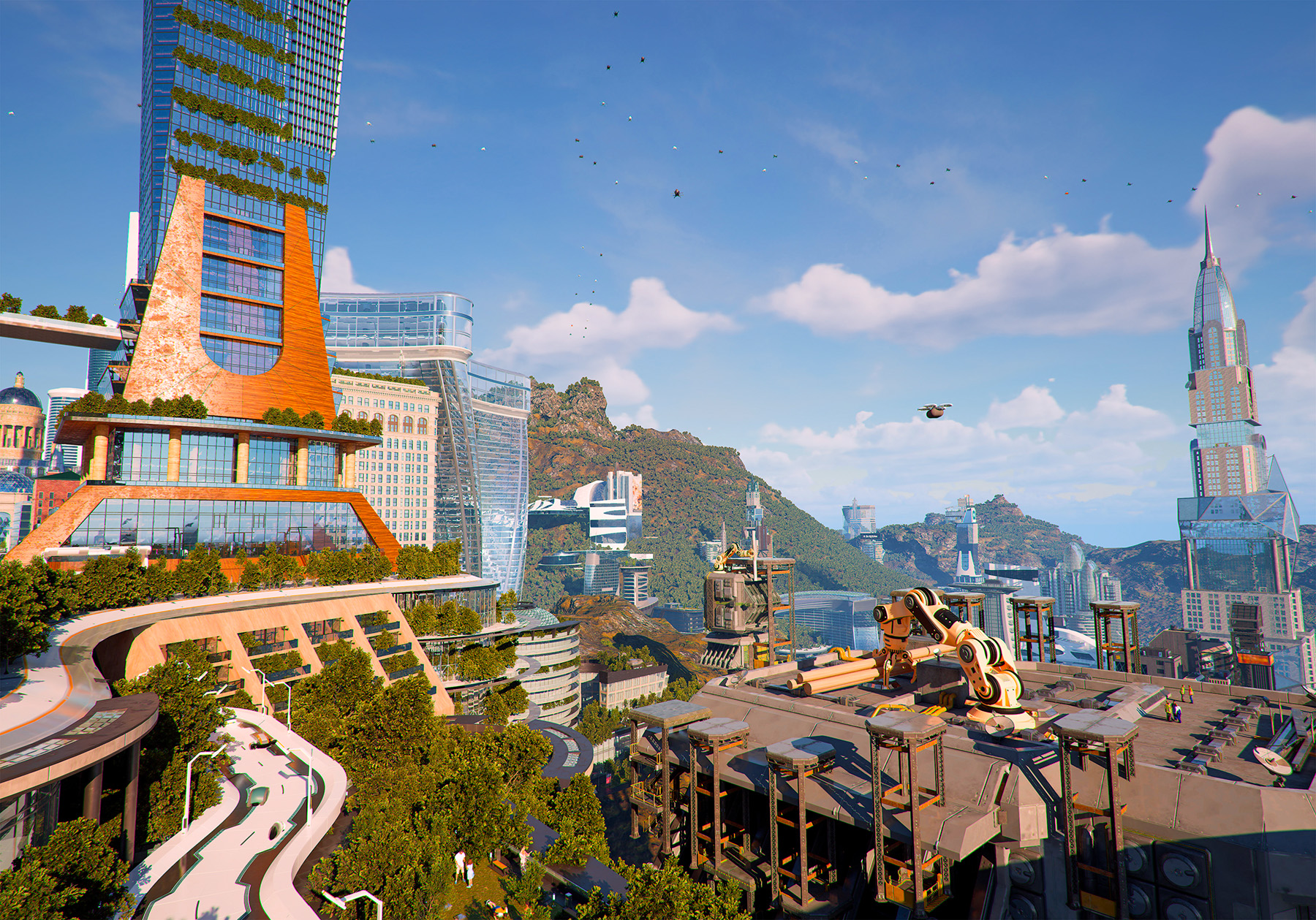
Learn more at the webinar “Meet the engineers behind the CGI” on Friday, April 19 at noon ET.
By Robert L. Reid
Extensive interactions between civil engineers and CGI artists helped make Cities of the Future a fascinating and realistic destination for IMAX audiences.
Although much of the new IMAX movie Cities of the Future takes place in the world of tomorrow, it is not science fiction, says David Odeh, P.E., S.E., F.SEI, F.ASCE, a principal at Odeh Engineers, which was acquired by WSP in October 2022. Odeh was one of several civil engineers who consulted with the digital artists who created the computer-generated images used throughout the giant-screen movie, which opened in select museums and theaters in February.
There are fictional aspects to Cities of the Future, Odeh explains, because the ultramodern buildings, transportation systems, and other infrastructure depicted in the film are not reality yet. “But they’re based on a realistic extrapolation of work we’re doing today,” he says.
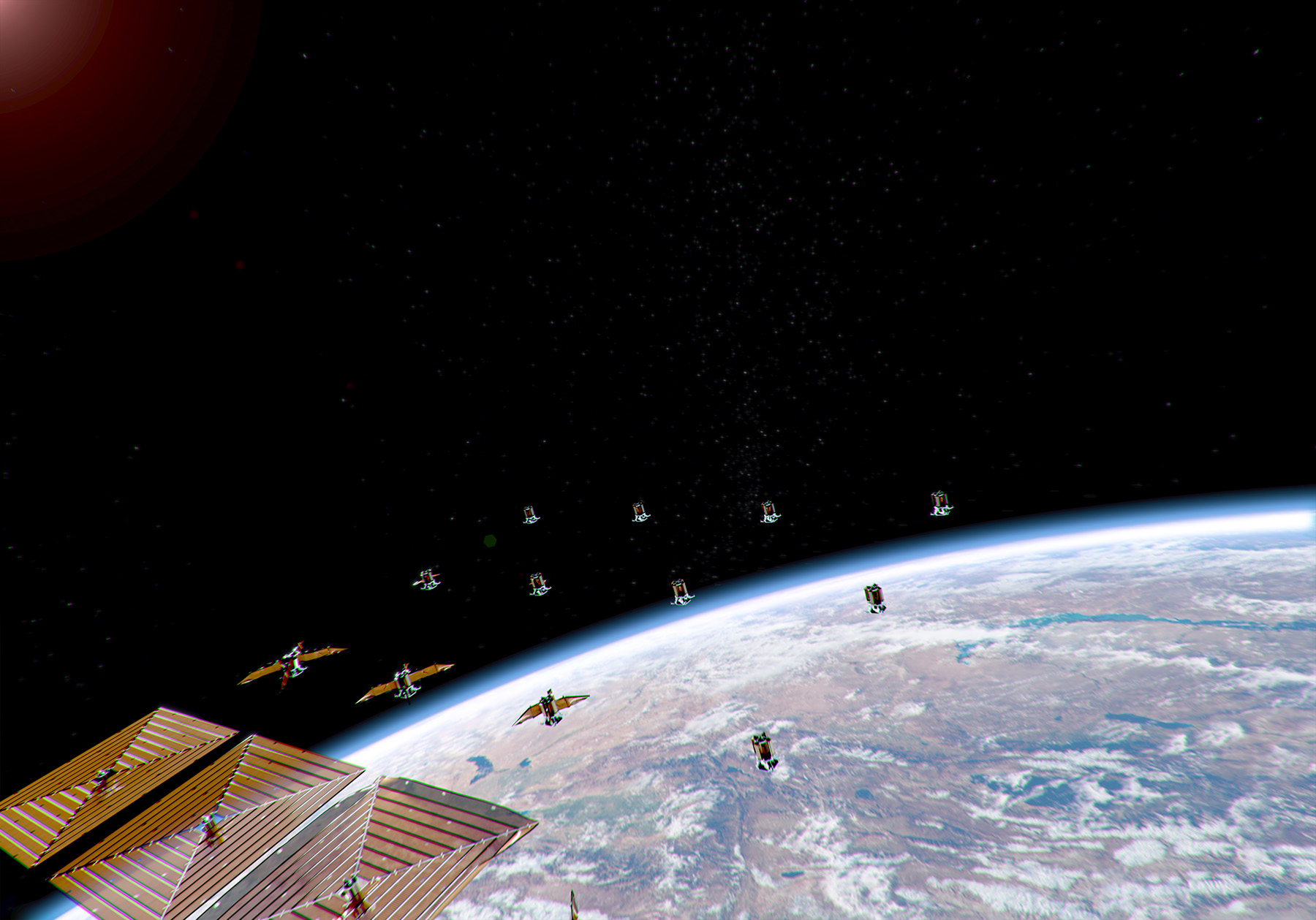
Likewise, Eva Lerner-Lam, NAE, M.SAE, F.ITE, M.ASCE, the founder and president of Palisades Consulting Group Inc. and another of the engineers who consulted with the CGI artists, stresses that the film focuses on concepts that have been “percolating in people’s heads for a long time.” These concepts range from futuristic approaches that are already in use — such as 3D-printed building materials and greenery-covered skyscrapers — to systems that are still under development, such as connected autonomous vehicles and aerial highways with flying cars.
Opening eyes to the future
Produced by MacGillivray Freeman Films, in partnership with ASCE, Cities of the Future was largely inspired by the Society’s Future World Vision initiative, particularly the Mega City 2070 project, says Odeh. Indeed, early in the development process, the MacGillivray Freeman team took a virtual “tour” of Future World Vision’s digital platform that “opened our eyes to the future!” says Mary Jane Dodge, the executive producer of Cities of the Future.
To create realistic images of a giant city in the future, MacGillivray Freeman turned to Odeh, Lerner-Lam, and other engineering experts via a series of virtual meetings held over more than a year. The filmmakers also carefully read through hundreds of written comments made by engineers following a screening of a draft version of Cities of the Future that was shown at the ASCE 2023 Convention in Chicago in October.
“One of the cool things about this, thinking 50 years into the future, is that it’s all based on real engineering data,” Dodge notes. “So the engineer advisers were super important to us when we were creating the CGI.”
Lerner-Lam credits Dodge and Jane Howell Lombardi, Aff.M.ASCE, ASCE’s chief communications officer, for “their dedication and passion for making this movie work.” These efforts included hours on the phone nearly every day over a period of months to ensure that any questions from the CGI artists were conveyed to the engineers, Lerner-Lam says.
Energetic opening
In the film’s opening sequence, viewers learn that the sun generates more energy in a single day than the entire population of Earth uses in a year. To capture that sustainable power and help combat climate change, engineers are developing an array of space modules that will spread out in Earth’s orbit, collect that solar energy, and beam it to Earth via microwaves. All of this is depicted in stunning CGI images of the sun, the Earth, the multiple arrays, and even the energy itself as it is transmitted from space to cities across the planet.
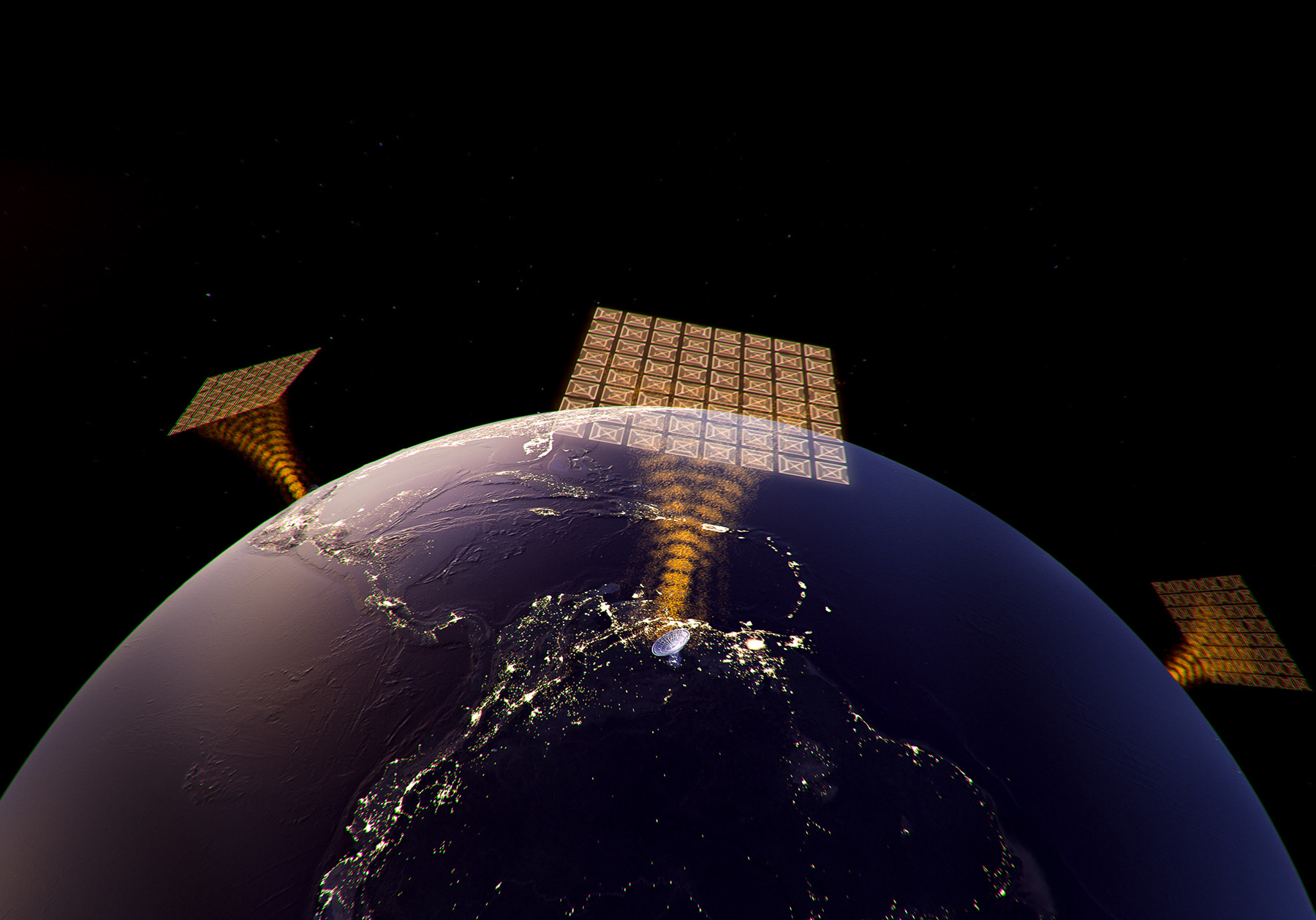
To create this scene, the film’s CGI artists collaborated with the team at the California Institute of Technology that is developing the actual Space Solar Power Project, a prototype of which was launched into orbit in January 2023. Led by SSPP co-directors Ali Hajimiri, Ph.D., the Bren Professor of Electrical Engineering and Medical Engineering at Caltech, and Sergio Pellegrino, M.ASCE, Ph.D., Caltech’s Joyce and Kent Kresa Professor of Aerospace and Civil Engineering, the project demonstrated its ability to wirelessly transmit power from space to the Earth’s surface for the first time in March 2023.
The sequence was especially challenging to depict in the film because the space solar power technology is still evolving, according to Alan G. Markowitz, the producer and founder of Visceral Image, one of two CGI firms that MacGillivray Freeman used on Cities of the Future. Thus, the CGI of the solar system had to continuously incorporate “the latest breakthroughs into our animations,” Markowitz explained in production notes from MacGillivray Freeman.
Light Sail VR is the other CGI firm that worked on the film, notes Dodge.
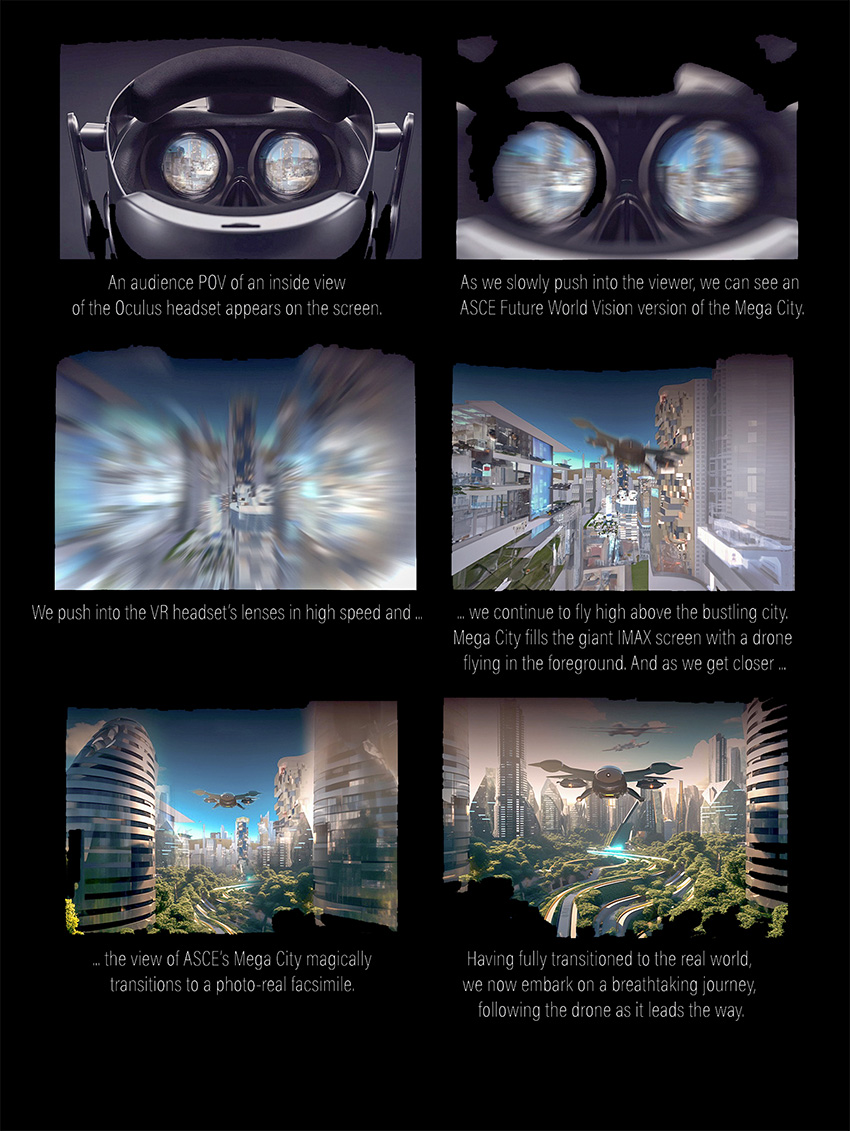
“During our initial meeting with ASCE engineers,” Markowitz says, “we introduced animatics — a series of conceptual renderings in the form of an animated storyboard, specifically designed for a climactic CGI shot appearing near the conclusion of the film, affectionately named the Big Reveal.”
The objective was to create “a compelling 2 1/2-minute journey through a futuristic mega city, where the audience would be fully immersed in the 3D environment,” Markowitz explains.
To do so, the CGI artists examined ASCE’s Future World Vision website, “drawing inspiration for the scenes in our Big Reveal sequence. Our storyboard panels included screenshots from different parts of a specific Future World Vision video, leading us to seek more clarity and specific details about its content because crafting an enjoyable and visually striking CGI sequence required a delicate balance between creative liberties, adopting a cinematic approach, and adhering to the engineers’ recommendations in line with the director’s overarching vision,” says Markowitz.
For Markowitz, the insights and suggestions from the engineers proved especially valuable. “Their input played a crucial role in refining our city design, ensuring it seamlessly aligned with their vision for a highly functional mega city. This collaborative exchange between our creative team, the engineers, and the director ultimately contributed to the enhancement and authenticity of this CGI sequence for the film.”
Urban improvements
At press time there were at least a half-dozen CGI scenes in Cities of the Future, including a segment set in Amsterdam. In this sequence, the audience gets a fish’s-eye view, so to speak, of an autonomous boat as it uses lidar and a specialized GPS device — depicted in brightly colored CGI images — to navigate along the city’s canal system. Likewise, an old building in Amsterdam is made new again, thanks to some 50,000 sensors used to control the lights, heating, and other systems within the structure — a concept portrayed in brilliant CGI colors and animation.
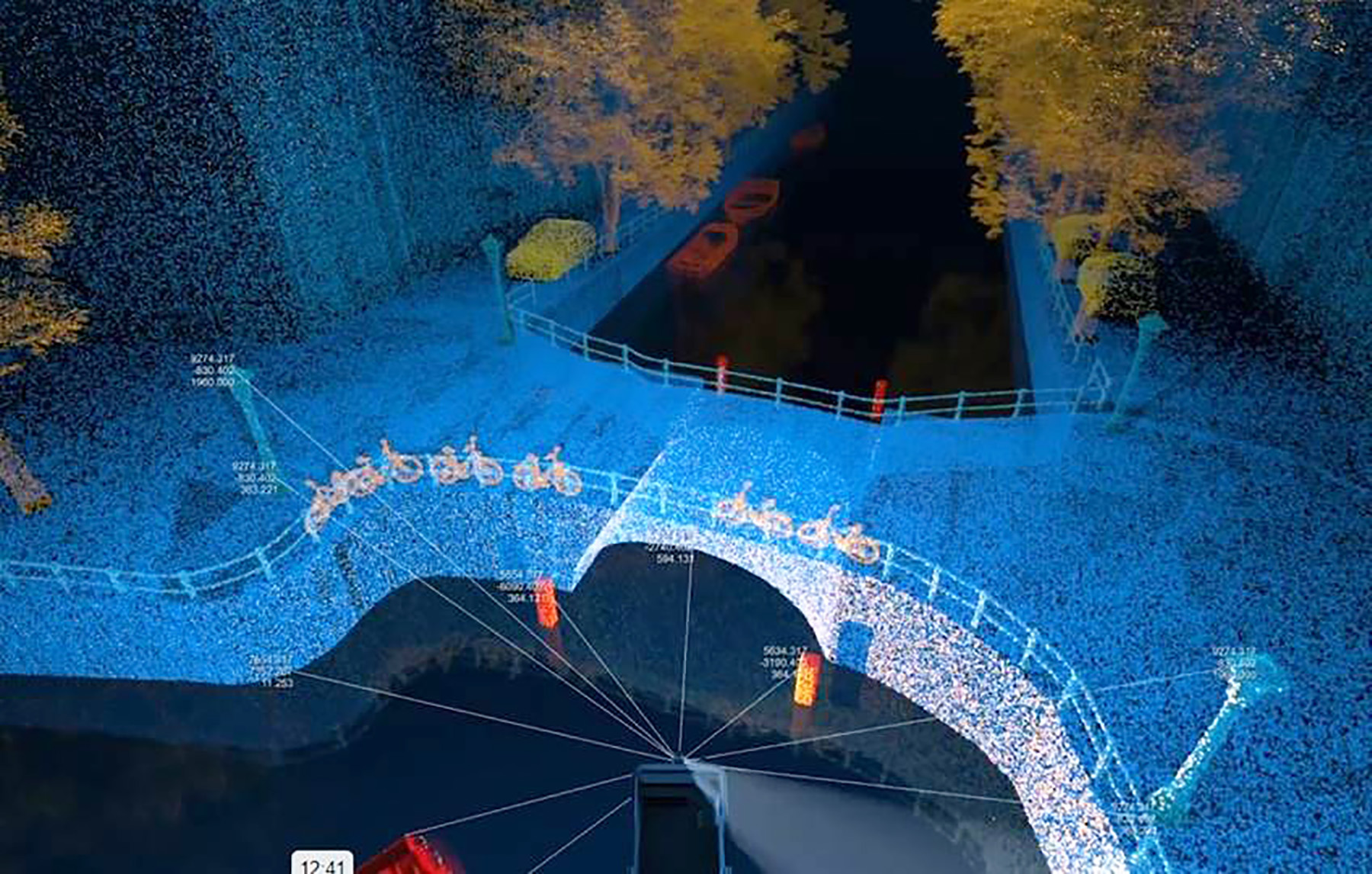
As the narrative flies forward, live action scenes of an actual air taxi from Joby Aviation — which recently held an exhibition flight in New York City for its electrically powered vertical takeoff and landing passenger aircraft — merge easily into a CGI segment that highlights flying taxis, drones, and other vehicles soaring through a futuristic skyline. The sequence features landing pads at various locations along the facades of tall structures — a point suggested by Lerner-Lam, who told the artists that “drones would fly not just to rooftops but also to apartments and offices midway up the buildings.”
The sequence also animates brightly colored corridors crisscrossing the sky, with yellow indicating the routes for flying drones, blue for air taxis, and other colors for other services. “The CGI artists did a great job” illustrating what Lerner-Lam calls “an aerial highway system.”
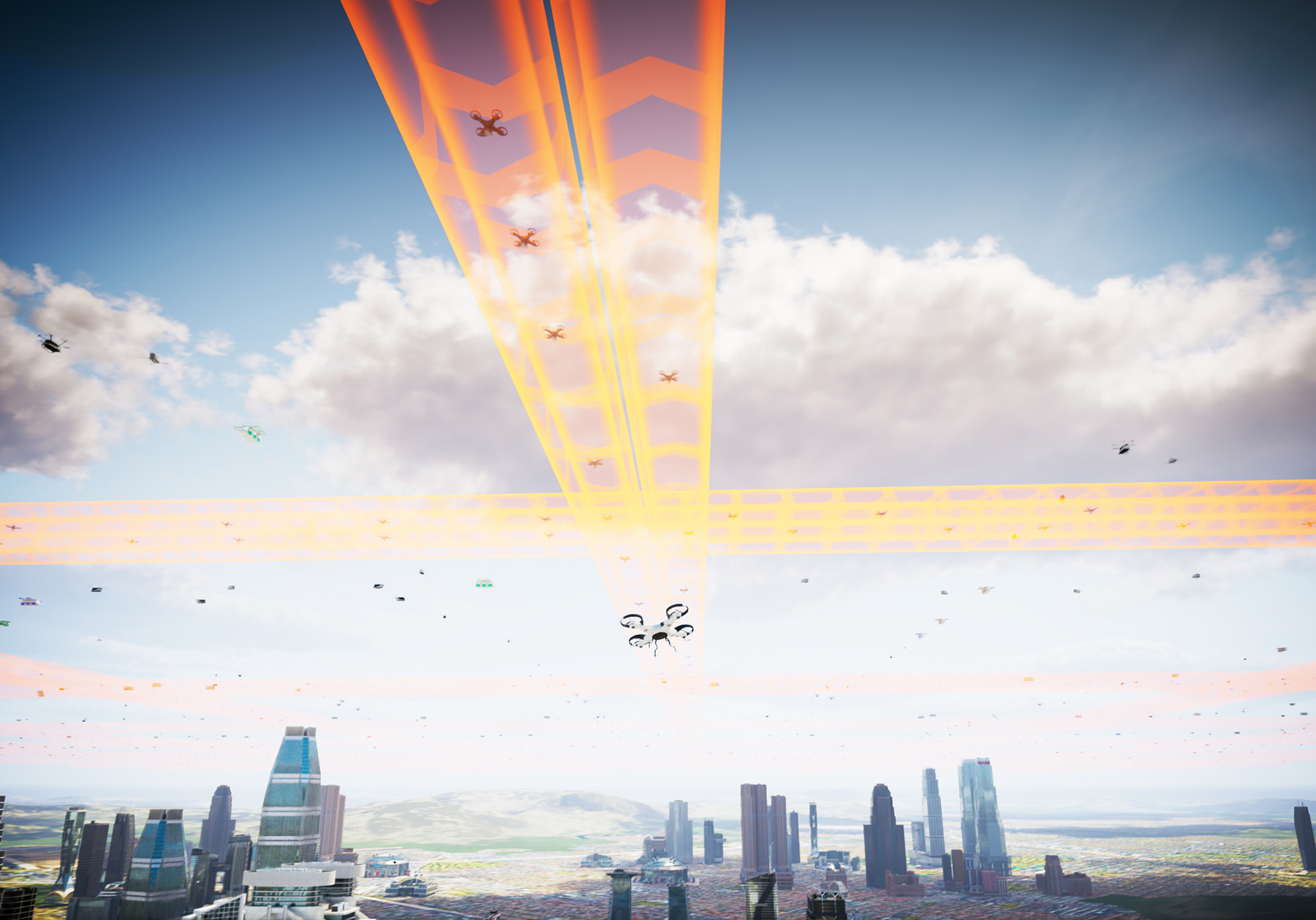
It is a system that can easily be prototyped now, Lerner-Lam says, by designating that every federal interstate or state road has an air corridor of a certain height above the concrete and asphalt to accommodate flying traffic. These air corridors would be operated according to “rules of the sky” to be determined by local, regional, state, and federal air traffic regulatory agencies, similar to the way local, regional, state, and federal roadways are regulated, she explains.
Working on many levels
Next, the film brings viewers back down to earth — eventually — by passing through a tri-level physical highway with different modes of mobility on each deck. Animated by Light Sail, the top level features walkways and parks for pedestrians, with the only vehicles being electric scooters or electric bicycles, says Lerner-Lam. The middle level is reserved for buses and other mass transit plus podlike autonomous and connected vehicles that can travel individually or in groups.
At ground level, large vehicles, such as freight trucks, garbage trucks, and other service vehicles will make deliveries or pick up loads. These functions work best at ground level so that engineers do not have to design the upper levels to accommodate the heavier weight of such vehicles, Lerner-Lam explains. “The top level was somewhat inspired by the High Line in New York but on a bigger scale with buildings connected to each other,” explains Alex Pearce, a senior creative technologist at Light Sail.

Input from the engineers helped the artists develop the autonomous pods on the second level, including the look and size of the pods, how they would move, and how many might travel together.
“One of the concepts that I find very exciting,” Pearce says, “is that since these pods know where the other pods are and where they are going, they can link up with other pods and travel much faster, then individually break off to exit as needed.”
Originally, the tri-level sequence included traffic lights and road signs. But those elements were removed in later versions because they would not be necessary in a city of the future in which vehicles can communicate with each other, Lerner-Lam explains.
A mix of old and new
Blaine Leonard, P.E., BC.GE, Pres.10.ASCE, the transportation technology engineer at the Utah Department of Transportation, has long conducted research on connected and autonomous vehicles, work that he discussed with the CGI artists. But they also talked about the overall futuristic city, especially its buildings — what they would look like and how feasible and buildable they would be. “Some of the early images had buildings that I think were structurally impossible!” Leonard adds, but the back and forth between the engineers and artists eventually produced far more realistic designs.
One idea the engineers especially stressed was that “the city of the future, in almost every case, will not be a brand-new city constructed from the ground up,” explains Leonard. Instead, “it will be a renovation and modification of today’s cities. So, there will be a mix of new, futuristic looking buildings and existing, historic structures that will be modified for reuse.”
The engineers emphasized that cities will “evolve over time and preserve spaces that are culturally important to people, and then we will find ways to reuse those historic spaces,” says Odeh. So, the artists added features to the future city, like a historic stadium, that were not depicted in some of the earlier visuals. “There are even some recognizable buildings that look like buildings you’d see in Los Angeles today that were either added or featured more prominently” as the CGI work progressed, Odeh says.
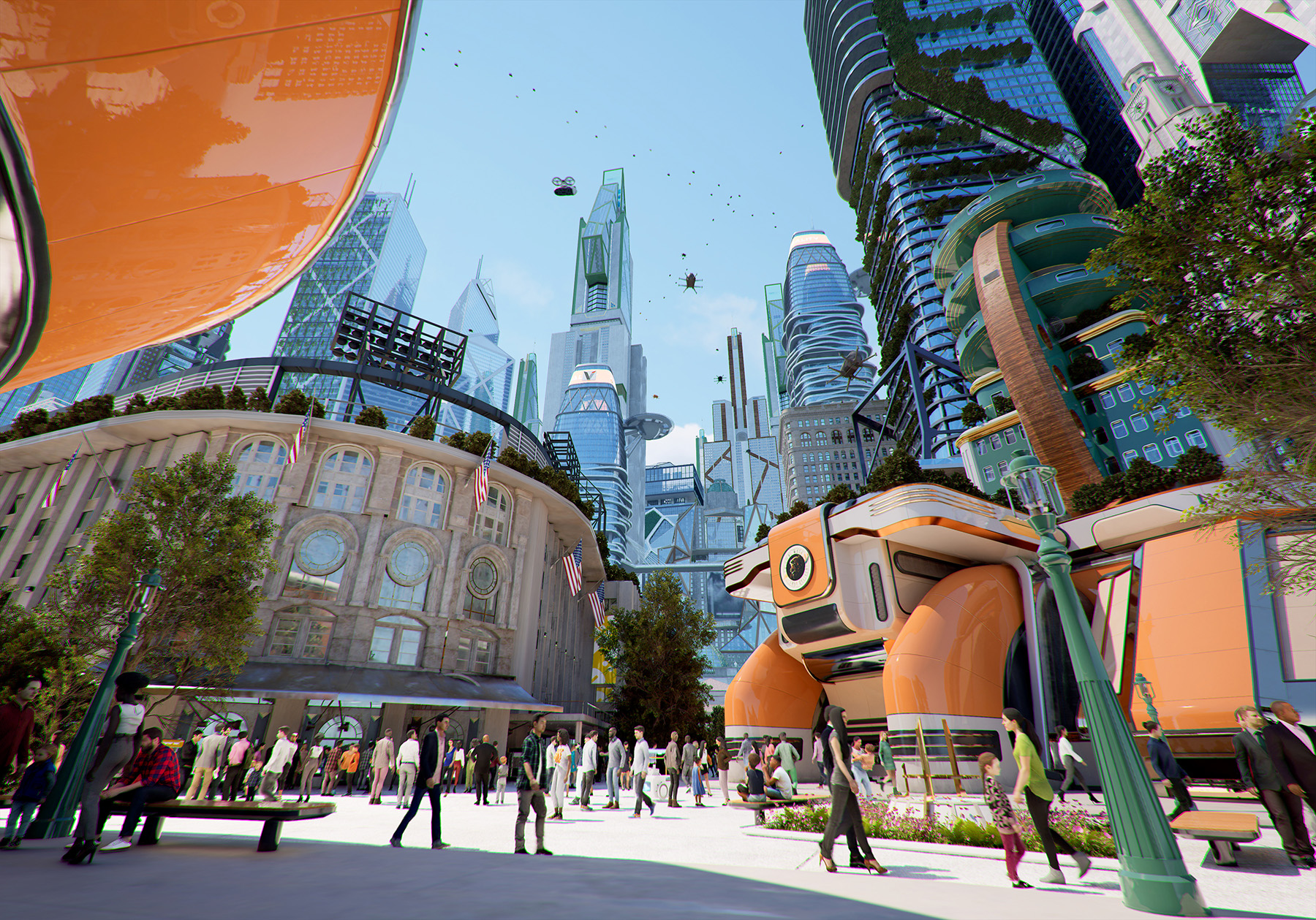
Building materials were also discussed, especially the need to include more timber framing and more natural elements overall, Odeh says. And in subsequent versions the use of wood, as well as trees and other green spaces, became more prominent, he adds.
The artists initially planned to depict structures made primarily of glass, steel, and aluminum. But the engineers’ insights “prompted a broader palette” that added wood and brick to the imagery, Markowitz says. “This deliberate diversification not only lends visual richness to our scenes but also aligns our depiction with a more eclectic and holistic representation of future architectural landscapes.”
The artists also helped stress the importance of structural engineering, which is often hidden behind building facades. In Cities of the Future, the work of civil and structural engineers is emphasized through scenes of buildings under construction as well as cantilevered elements and exposed structural systems, Odeh adds. And in keeping with the futuristic focus, there is also a sequence that depicts a structure being erected via 3D printing.
As Markowitz explains, the collaboration with the engineers “delved into the nuanced realm of repurposing and retrofitting existing, older iconic buildings within our envisioned mega city, offering a dynamic layer of authenticity to our visual narrative.”
Interaction and cooperation
Toward the end of the film — during the Big Reveal sequence Markowitz described earlier — children participating in a future cities project don virtual reality goggles to take an extended tour of a mega city that presents a bright and green place filled with technological wonders. For the engineers who worked on the sequence with the film’s CGI artists, the experience was enlightening, literally and figuratively.
On the literal side, the early versions of the animations depicted a somewhat dark setting, “which may have been just because the animators weren’t far along in production,” Leonard says. But the engineers stressed that “if we’re successful in building these cities of the future the way we want to, they’ll be bright places, full of natural light and clean air,” Odeh says.
And in the subsequent versions, the imagery became lighter and continued to improve.
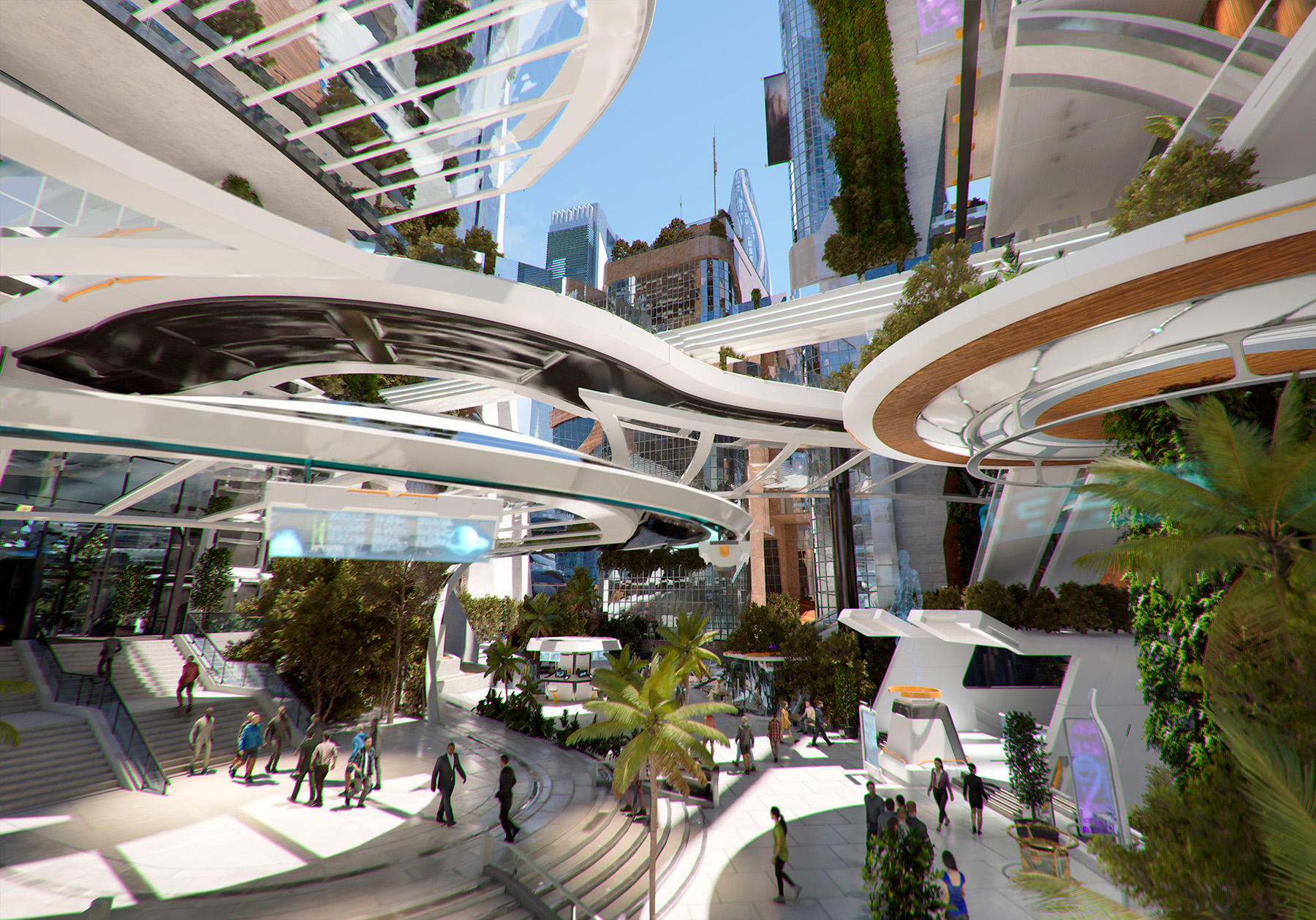
Figuratively, the engineers were enlightened as to the creative processes that produced the CGI animations. Initially, the CGI artists shared still images with the engineers, then progressed into animated sequences, says Odeh. “We started with just a couple of big-picture, zoomed-out views of what the city might look like and then got into more specifics as time went on.”
On several occasions “we viewed the animation of an aerial vehicle, an electric flying car, coming in and landing on a platform high up a building,” says Leonard. “The images were very preliminary, but we could see the concept that was being developed, so we talked about that vehicle and where it landed and how it would be charged and some of the practical implications.”
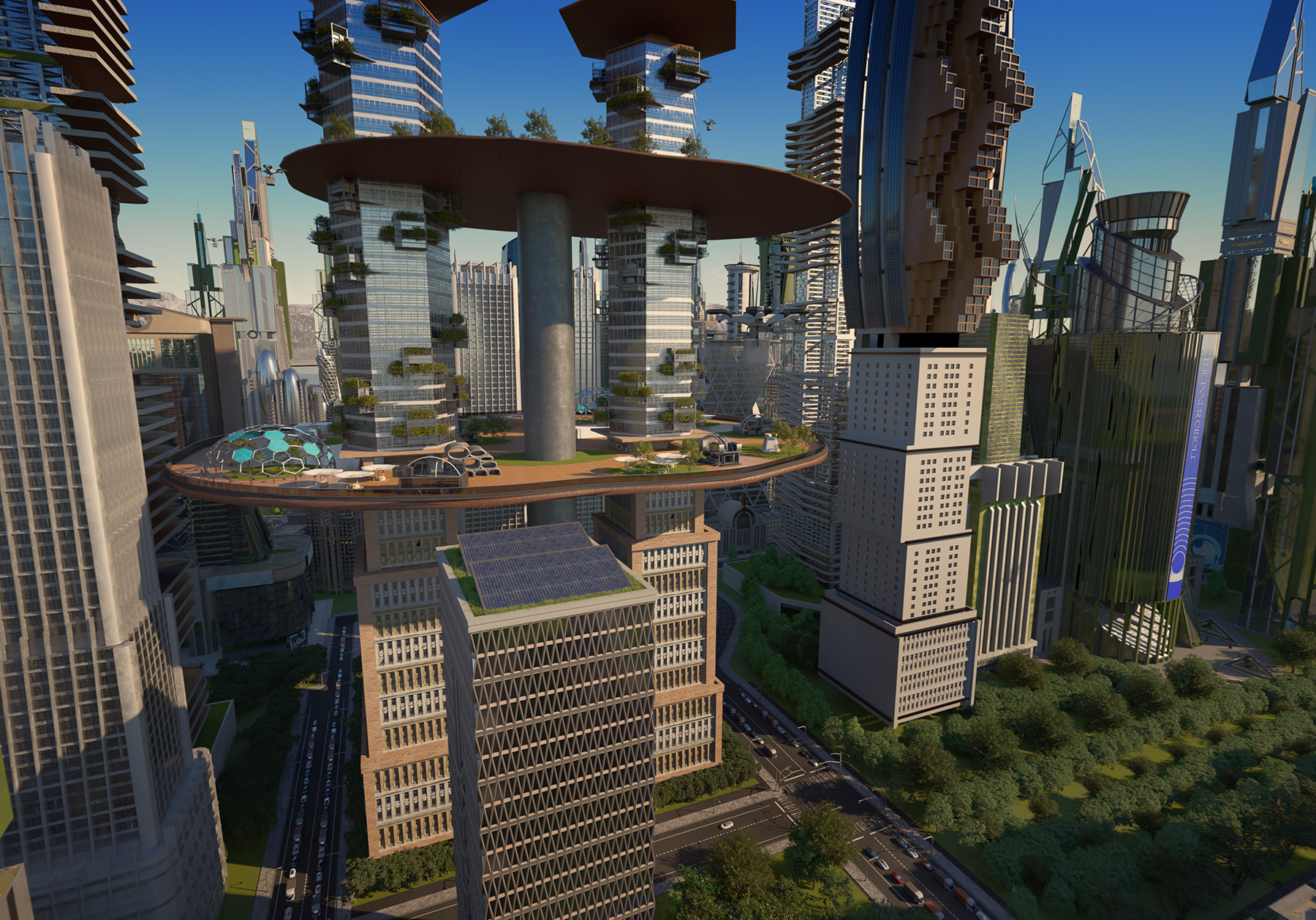
Although most of the CGI sequences last only about 20 or 30 seconds — with just the finale taking several minutes — the creation of those segments involved months of effort and multiple iterations for each scene, says Dodge. The process generally started with simple conceptual versions of buildings, followed by digital models that incorporated feedback from the engineers, she explains. The initial images were fairly low resolution, Dodge adds, but these digital structures were produced in higher and higher resolutions as the final forms evolved.
One of the greatest challenges Pearce faced as an artist “was to separate what I think about futuristic cities from how futuristic cities might actually look and behave. The engineers were great for helping us understand the reality of what the near future might actually be. For example, we had this cool idea that maybe cars of the future would be charged by some energy source underground while they drive, but the engineers helped remind us that a system of that size would be difficult to create and maintain and wouldn’t be the most efficient use of resources.”
Likewise, the extensive use of trees, plantings, and other vegetation in the animated sequences “was a direct reflection of the engineers’ feedback to how important greenery will be for cities in the future,” Pearce says.
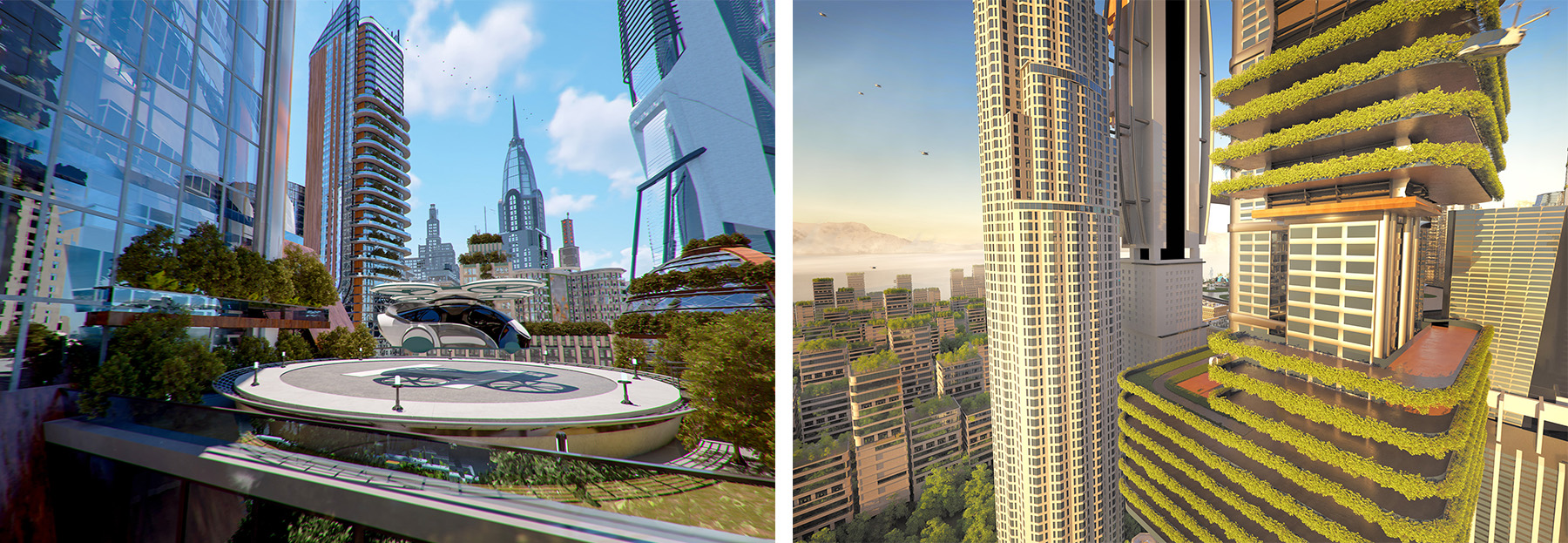
On the engineers’ side, Leonard was intrigued by “the whole process of how an animation is developed, how complex it is, and how much thought goes into developing those images. The animators were very engaged in discussions with us, really interested in our input, willing to bounce ideas back and forth, ask us questions about our suggestions. The interaction in the process was more involved than I expected.”
Ultimately, that combination of creativity, technical expertise, and cooperation between the engineers and the artists is what makes Cities of the Future such a fantastic and realistic destination for movie audiences.
Get out the popcorn and prepare to see tomorrow!
Robert L. Reid is the senior editor and features manager of Civil Engineering.
This article first appeared in the March/April 2024 print issue of Civil Engineering as “Engineering the Art.”
Join us for the webinar “Meet the engineers behind the CGI” on Friday, April 19 at noon ET.



